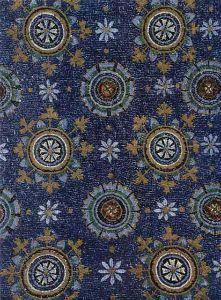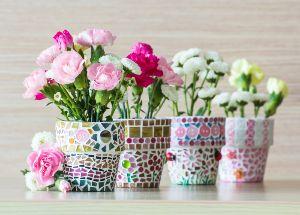Mosaic
Post from EditorialsThe mosaic is used not only for the creation of valuable flooring for interior decorations but also to create small masterpieces of creative recovery.
A brief history of mosaic
The mosaic is one of the first forms of art practiced by man: it seems that the most ancient mosaics date back to the second half of the fourth century BC in Greece, in the regions of Macedonia and Euboea. In the Hellenistic age, had spread a processing technique called vermiculation, through the use of very small tiles, that donated to the artifacts a particular painterly effect: the most famous work in this direction is the Battle of Issus from the House of the Faun in Pompeii .
In the Hellenistic age, had spread a processing technique called vermiculation, through the use of very small tiles, that donated to the artifacts a particular painterly effect: the most famous work in this direction is the Battle of Issus from the House of the Faun in Pompeii .
In Roman times, the mosaics were used for the construction of floorings decorated in luxurious villas of the nobles, in which even the walls were adorned with precious mosaics where the figures seem almost real. Our country is rich in works decorated with this ancient technique: the most famous example is perhaps that of the Byzantine mosaics in the Mausoleum of Galla Placidia, and Arian Baptistry in Ravenna. It is made of polychrome mosaic works around the fifth century AD: its striking dome, which represents a sky lit by 570 stars, is the backdrop to scenes linked to the Four Animals of the Apocalypse and the Apostles. It seems that the beauty of this work has inspired the famous musician Cole Porter, on a visit to Italy, in the writing of his famous Night and Day.
Our country is rich in works decorated with this ancient technique: the most famous example is perhaps that of the Byzantine mosaics in the Mausoleum of Galla Placidia, and Arian Baptistry in Ravenna. It is made of polychrome mosaic works around the fifth century AD: its striking dome, which represents a sky lit by 570 stars, is the backdrop to scenes linked to the Four Animals of the Apocalypse and the Apostles. It seems that the beauty of this work has inspired the famous musician Cole Porter, on a visit to Italy, in the writing of his famous Night and Day.
Today, this versatile technique is used not only for the production of fine and decorative paving in public and private environments, but also to make products DIY: dishes, vases, trivets and even garden furniture can be decorated with mosaic tiles, virtually an exercise of creative recovery.
Decorate a vase with the mosaic technique
Here is a fairly simple project, dedicated to those who want to try for the first time in the ancient technique of mosaic: therefore choose a vase not too big, maybe a recovery one. Ideals are the terracotta garden pots: their regular shape may make easier the processing steps.
Here is the necessary to the realization of this project:
- Tesserae for the mosaic;
- Glue for mosaic;
- Colored stucco;
- Pliers to cut the tesserae;
- Latex gloves and sponge.
Where to buy the tesserae? Meanwhile it is good to know that the materials they are made of may be different: glass and glass pastes for the Venetian mosaic, marble and natural stones of different kinds are the most popular. On the web you can find companies that deal with the processing of the tesserae working upstream of the selection of materials, this is what Pietreesassi take care of, a company specializing in the production and sale of natural stone flooring, cladding and mosaics, which you can buy online. Artemarcia is an online shop where, among other items, you can find a varied selection of tesserae and equipment for the mosaic.
On the web you can find companies that deal with the processing of the tesserae working upstream of the selection of materials, this is what Pietreesassi take care of, a company specializing in the production and sale of natural stone flooring, cladding and mosaics, which you can buy online. Artemarcia is an online shop where, among other items, you can find a varied selection of tesserae and equipment for the mosaic.
Once you have got what you need, you can begin your work: worn gloves, the first thing to do is clean the surface on which you run the job. In the case of a terracotta vase, simply wipe it with a dry cloth to remove dust and dirt that would not allow the glue to get a good grip. When you have done this, with a small flat brush, past a thick layer of glue on the vase and on the back of each card: then attach it to the surface of the pot by making a slight pressure.
When you have done this, with a small flat brush, past a thick layer of glue on the vase and on the back of each card: then attach it to the surface of the pot by making a slight pressure.
The advice is to do in order to leave more or less the same gap between a tessera and the other, which means that all of the tiles should have a similar shape. If this is not the case, it will be necessary to fix them by cutting them with pliers.
Once you have covered the entire vase, it is necessary to wait for the glue to dry completely: this step is very important because the moisture caused by an incomplete drying of the glue may cause small cracks in stucco and unsightly. The best ones might even try to make a design on the vase To do so drawn to scale 1:1 your decor and, using carbon paper, return it on its surface. When you begin to attach the tiles, I recommend that you first compose the drawing so you will be facilitated in the choice of tiles to use as a filling.
The best ones might even try to make a design on the vase To do so drawn to scale 1:1 your decor and, using carbon paper, return it on its surface. When you begin to attach the tiles, I recommend that you first compose the drawing so you will be facilitated in the choice of tiles to use as a filling.
It is now possible to cover our vase of colored stucco: you should choose the color in accordance with the prevailing color of the tiles, so as to achieve a more pleasing effect. Once it has dried up, the excess of grout will be removed gently with a damp sponge.
Following the same method as mentioned earlier, you can decorate dishes of different sizes, create original trivets and even try your hand in the decoration of small furniture.
79832 REGISTERED USERS










